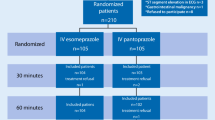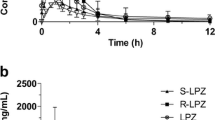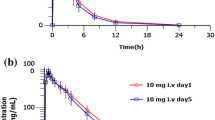Abstract
Background: An intravenous (IV) formulation of esomeprazole has been developed as an alternative to oral administration. To meet the needs of different clinical situations it would be preferable if an IV dose could be administered as either an injection or an infusion, while producing similar effects.
Aim: To compare the effects of IV esomeprazole 40mg given as a 3-minute injection or a 30-minute infusion on intragastric pH during single and repeated once-daily dosing in healthy subjects.
Methods: In this single-centre, double-blind, double-dummy, randomised, two-way crossover study, subjects were randomised to receive either a 3-minute IV injection or a 30-minute IV infusion of esomeprazole 40mg. Both regimens were given once daily for 10 days. After a washout period of at least 13 days, subjects were crossed over to the other treatment. Intragastric pH monitoring was performed on days 1 and 10. Blood samples were also taken throughout days 1 and 10.
Results: Data were available from 41 subjects. Time with intragastric pH >4 was 3.1h/24h at baseline, increasing to almost 8h in association with IV esomeprazole injection or infusion on day 1, and to >13h on day 10. Geometric mean time with pH >4/24h ratios (injection/infusion) were 0.99 on day 1 and 1.03 on day 10. Mean esomeprazole AUC values were approximately 15% higher with the injection than the infusion, but 90% CI limits for geometric mean AUC ratios ranged from 1.07 to 1.23, indicating bioequivalence.
Conclusions: IV esomeprazole 40mg provides similarly potent acid control whether administered by injection or infusion.






Similar content being viewed by others
References
DiPalma JA. Management of severe gastroesophageal reflux disease. J Clin Gastroenterol 2001; 32: 19–26
Miner Jr P, Katz PO, Chen Y, et al. Gastric acid control with esomeprazole, lansoprazole, omeprazole, pantoprazole, and rabeprazole: a five-way crossover study. Am J Gastroenterol 2003; 98(12): 2616–20
Röhss K, Lind T, Wilder-Smith C. Esomeprazole 40mg provides more effective intragastric acid control than lansoprazole 30mg, omeprazole 20mg, pantoprazole 40mg and rabeprazole 20mg, in patients with gastroesophageal reflux symptoms. Eur J Clin Pharmacol 2004; 60(8): 531–9
Newton M, Kamm MA, Quigley T, et al. Symptomatic gastroesophageal reflux in acutely hospitalized patients. Dig Dis Sci 1999; 44(1): 140–8
Vinayek R, Frucht H, London JF, et al. Intravenous omeprazole in patients with Zollinger-Ellison syndrome undergoing surgery. Gastroenterology 1990; 99(1): 10–6
Tripathi A, Somwanshi M, Singh B, et al. A comparison of intravenous ranitidine and omeprazole on gastric volume and pH in women undergoing emergency caesarean section. Can J Anaesth 1995 Sep; 42(9): 797–800
Chua RT, Lin HJ, Wang K, et al. Intravenous omeprazole prevents rebleeding in peptic ulcer patients with a non-bleeding visible vessel: a preliminary report of a randomized controlled study. Zhonghua Yi Xue Za Zhi (Taipei) 1996; 57(2): 139–45
Lau JY, Sung JJ, Lee KK, et al. Effect of intravenous omeprazole on recurrent bleeding after endoscopic treatment of bleeding peptic ulcers. N Engl J Med 2000; 343(5): 310–6
Geus WP. Are there indications for intravenous acid-inhibition in the prevention and treatment of upper GI bleeding? Scand J Gastroenterol Suppl 2000; (232): 10–20
Röhss KM, Bondarov P, Lundin CB, et al. Esomeprazole 20 and 40mg administered as a 30 min infusion provides a similar level of acid control as oral administration in healthy subjects. Eur J Gastroenterol Hepatol 2005; 17: 191–7
Wilder-Smith CH, Gennoni MA, Triller J, et al. Is a fluoroscopic verification of the electrode position necessary in ambulatory intragastric pH monitoring? Digestion 1992; 52(1): 1–5
Lagerström PO, Persson BA. Determination of omeprazole and metabolites in plasma and urine by liquid chromatography. J Chromatogr 1984; 309(2): 347–56
Chiba N. Proton pump inhibitors in acute healing and maintenance of erosive or worse esophagitis: a systematic overview. Can J Gastroenterol 1997; 11Suppl. B: 66B–73B
Wilder-Smith CH, Röhss KM, Bondarov P, et al. Esomeprazole 40mg IV provides faster and more effective intragastric acid control than pantoprazole 40mg IV: results of a randomized study. Aliment Pharmacol Ther 2004; 20: 1099–104
Armstrong D, Bair D, James C, et al. Oral esomeprazole vs. intravenous pantoprazole: a comparison of the effect on intragastric pH in healthy subjects. Aliment Pharmacol Ther 2003; 18: 705–11
Metz DC, Pratha V, Martin P, et al. Oral and intravenous dosage forms of pantoprazole are equivalent in their ability to suppress gastric acid secretion in patients with gastroesophageal reflux disease. Am J Gastroenterol 2000; 95: 626–33
Andersson T, Miners JO, Veronese ME, et al. Identification of human liver cytochrome P450 isoforms mediating secondary omeprazole metabolism. Br J Clin Pharmacol 1994; 37(6): 597–604
Acknowledgements
This study was supported by a grant from AstraZeneca, Mölndal, Sweden. The authors would like to thank Noel Curtis for editorial assistance in the preparation of the manuscript. AstraZeneca provided financial support for this assistance.
Author information
Authors and Affiliations
Corresponding author
Rights and permissions
About this article
Cite this article
Wilder-Smith, C., Röhss, K., Bondarov, P. et al. Intravenous Esomeprazole 40mg is Effective for the Control of Intragastric Acid Levels Whether Given as a 3-Minute Injection or a 30-Minute Infusion. Clin. Drug Investig. 25, 517–525 (2005). https://doi.org/10.2165/00044011-200525080-00004
Published:
Issue Date:
DOI: https://doi.org/10.2165/00044011-200525080-00004




